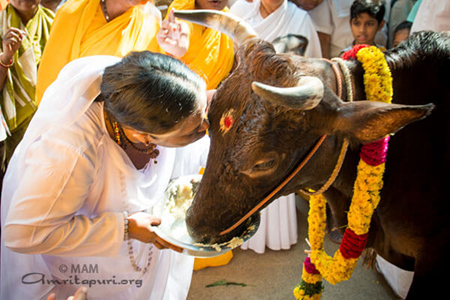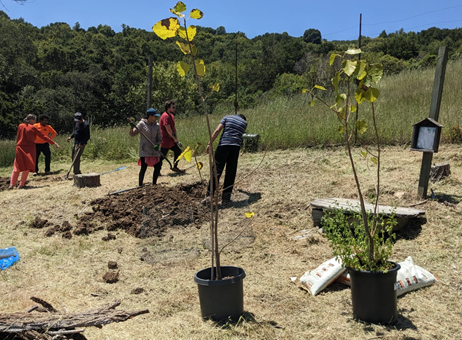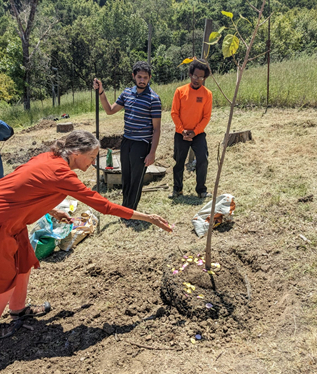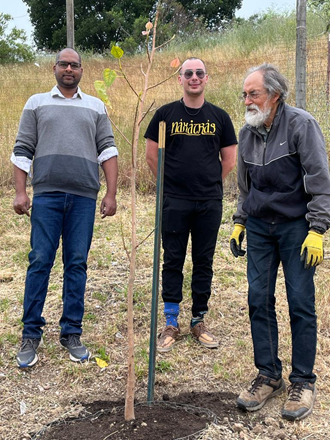
| Home | Source Reduction | Friends of Green Friends | Newsletters |
| Gardening | Resources | What You Can Do | Embracing The Trees |
|
Ashwattha Trees at MA Center San Ramon |
 |
| "Nature is Kamadhenu* --- the the divine, wish-fulfilling cow that bestows prosperity on all. But at present, it is like an ailing cow whose udders have dried up and which is on the verge of death. The number of forests on earth has dwindled. Food is becoming scarce. Pure air and water are no longer available. There is an increase in the incidence of diseases.
If we take from Nature only enough to sustain ourselves, there will be sufficient food, water and clothes for everyone. Nature will regain her vitality and once again become like Kamadhenu." - Amma * From ancient Indian creation mythology |
 Planting site with original peetam for Amma's meditation |
| We recently planted three ashwattha trees in the Temple garden at MA Center San Ramon.
The ashwattha tree, Ficus religiosa, also known as the bodhi tree or peepal tree, is a sacred tree in India. This is the tree species that Gautama Buddha attained liberation under while meditating. In the Bhagavad Gita, the ashwattha tree symbolizes both the eternal Self and the embodied self. Lord Krishna says, "Among trees I am the ashwattha". The Ashwattha tree is one of 5 sacred trees in India known collectively as the panchavati. They comprise a sacred grove of at least one of each of the following trees: Ashwattha (Ficus religiosa, Peepal), Bilva (Aegle marmelos), Amalaki (Phyllanthus embilica), Ashoka (Saraca asoca), and Banyan (Ficus benghalensis). Many people are familiar with the sacred Panchavati grove mentioned several times in the 'Gospel of Sri Ramakrishna Paramahansa'. It was a favorite grove of trees where Sri Ramakrishna and other close devotees would go for meditation and reflection. Our three ashwattha trees were planted over 2 weekends, June 3rd and June 10th, 2023 by several volunteers. They were planted in a special area above the Temple where Amma led one of the first group meditations on the property, circa 1991. These trees were started a few years ago from seed by Rajam Namboodiri, long time Amma devotee and avid gardener. When they grew to small saplings, she gave them to the ashram as small plants in 4 inch pots and we have been moving them up into larger and larger pots ever since, while we waited for the drought to end. We also needed to feel more confident that they would survive here in our climate. But after the recent winter season and so many frosty mornings we noticed that they had survived without losing all their leaves. So the auspicious planting days finally arrived! |
|
|||
|
Volunteers, led by AYUDH members Naveen and Amar, worked hard digging large deep holes into the clay soil. Prakash, Anupama and Anvi also joined in. Finally one resident, Jason, came to the rescue with an auger to aid in the digging by drilling first to loosen up the soil. Wire cages were made and dropped into the holes before planting to help protect the roots from gophers. George, Bhavanish and Amar came later again to top up the soil around the roots. Temporary wire fencing was placed around them to protect them until the branches can get a bit taller and out of reach of the deer that usually find a way into the Temple garden. The trees are planted on sloping ground so they will have good drainage. And they are higher on the hill so that the first rays of the sun will reach them and reduce the amount of time they will be exposed to frost during winters. When finished with the planting for the day, all volunteers gathered around the trees to offer flowers and incense and pray for the peace and happiness of all beings. |
|||
 Offering flowers and prayers |
|||
| We pray that the special site in the Temple garden where Amma sat with us for meditation will become our own sacred Panchavati grove with a mix of sacred trees of east and west, ashwattha, bilva, live oak, olive, and carob. When the site is finished, it is envisioned to be a quiet place to rest, reflect, pray, meditate, and commune with Nature.
The ashwattha is sacred in Sanatana Dharma as it represents the universe, which is considered the physical manifestation of the Divine and reminds us of the teaching 'Vasudeva Kutumbakam' meaning 'the world is one family'. The bilva tree is related to the worship of Lord Shiva. Each leaf has three leaflets which represent the universal cycles of creation, preservation and destruction, which repeat over and over again. The live oak is a California native tree and is considered the 'tree of life' to native Californians. For many European cultures it symbolizes an abundance of virtuous qualities. Among them are safety, wisdom, stability, strength, resilience, perseverance, justice and honesty. The olive tree has been singled out as special from ancient times and grows very well in California. It is a symbol of peace, friendship, reconciliation and victory. Since ancient times, olive oil kept the oil lamps lit in the Jewish Tabernacle, which is considered the dwelling place of God. The carob tree is considered a symbol of humility. The sweet carob pods are nutritious and known as 'Saint John's bread' or 'poor man's bread' since they would bear fruit in the very dry summers of the Holy Land of Israel and were said to have sustained John the Baptist in the desert. If you come to the Bay Area and visit MA Center San Ramon, you are welcome to come and enjoy the gardens and trails, to breathe the fresh air, commune with Nature and feel the peaceful sacred atmosphere. Maybe it will inspire you to create your own sacred garden at home, a place to refresh yourself in the healing presence of Mother Nature. Temple Garden Team - MA Center San Ramon, CA |
Read How a Food Rescue Initiative Sprouted from Amma’s Teachings in the Q3 2023 newsletter >>
| Home | Source Reduction | Friends of Green Friends | Newsletters | Resources | What You Can Do | Embracing The Trees |
For more information, e-mail info@greenfriendsna.org |
||||||
 Anvi, Naveen and Amar digging a tree hole
Anvi, Naveen and Amar digging a tree hole
